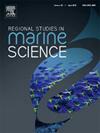Sea level rise assessment in the Persian Gulf and Arabian Sea using geodetic observations
IF 2.1
4区 环境科学与生态学
Q3 ECOLOGY
引用次数: 0
Abstract
Sea Level Rise (SLR) due to climate change is a significant concern, especially for coastal areas, posing risks to infrastructure and inhabitants. The Persian Gulf (PG) and the Arabian Sea (AS) are two vital regions, recognized for their strategic geopolitical importance, underscoring the need to evaluate sea level changes thoroughly. This study aims to quantify and analyze SLR and identify its spatiotemporal variability across the PG and AS using trend analysis and a tensor-based approach, employing tide gauge records and satellite altimetry observations. Monthly Mean Sea Level (MSL) measurements from 14 tide gauge stations in the PG and AS, from 1993 to 2021, were examined and exhibited an upward trend ranging from 0 to 100 mm per decade (mm/dec). Satellite altimetry data, presented as mean Sea Level Anomaly (SLA) across the area and gridded SLA observations from 1993 to 2022, were analyzed and it revealed an ascending trend of approximately 46 and 39 mm/dec for the PG and AS, with the notable rise in the mean SLA trend beginning around 2005. To enhance the gridded SLA data analysis, a 3D tensor was constructed, with two axes representing latitude and longitude, and the third axis representing time. A final trend map was derived from the 3D SLA tensor to illustrate the SLA trends across different locations within these regions. The SLA trend varied from 15 to 55 mm/dec, with eastern AS exhibiting the highest, while the lowest trends occurred west of AS. The coastlines generally experienced higher SLA trends compared to the nearby deep ocean. These findings underscore the growing vulnerability of some coastal zones in the PG and AS to rising sea levels, highlighting the need for adaptive coastal management strategies. The trend map derived from the SLA tensor provides valuable insights for identifying the most vulnerable zones.
波斯湾和阿拉伯海使用大地测量观测评估海平面上升
气候变化导致的海平面上升(SLR)是一个重大问题,特别是对沿海地区,对基础设施和居民构成威胁。波斯湾(PG)和阿拉伯海(AS)是两个至关重要的地区,因其战略地缘政治重要性而得到认可,强调了彻底评估海平面变化的必要性。本研究旨在运用趋势分析和基于张量的方法,利用验潮记录和卫星测高观测资料,量化和分析青藏高原和青藏高原的单反,并确定其时空变异。研究了1993年至2021年太平洋和太平洋地区14个测潮站的月平均海平面(MSL)测量结果,发现海平面上升趋势为0 ~ 100 mm /dec / 10年。分析了1993 - 2022年区域平均海平面异常(SLA)和网格化SLA观测的卫星高度资料,发现PG和as的平均海平面异常(SLA)呈上升趋势,分别为46和39 mm/dec,平均SLA趋势在2005年前后开始显著上升。为了增强网格化SLA数据的分析能力,构建了一个三维张量,其中两个轴代表经纬度,第三个轴代表时间。从3D SLA张量中导出了最终的趋势图,以说明这些区域内不同位置的SLA趋势。SLA变化趋势为15 ~ 55 mm/dec, AS东部趋势最高,AS西部趋势最低。与附近的深海相比,海岸线通常经历更高的SLA趋势。这些发现强调了PG和AS的一些沿海地区对海平面上升的脆弱性日益增加,强调了适应性沿海管理战略的必要性。从SLA张量导出的趋势图为识别最脆弱的区域提供了有价值的见解。
本文章由计算机程序翻译,如有差异,请以英文原文为准。
求助全文
约1分钟内获得全文
求助全文
来源期刊

Regional Studies in Marine Science
Agricultural and Biological Sciences-Ecology, Evolution, Behavior and Systematics
CiteScore
3.90
自引率
4.80%
发文量
336
审稿时长
69 days
期刊介绍:
REGIONAL STUDIES IN MARINE SCIENCE will publish scientifically sound papers on regional aspects of maritime and marine resources in estuaries, coastal zones, continental shelf, the seas and oceans.
 求助内容:
求助内容: 应助结果提醒方式:
应助结果提醒方式:


